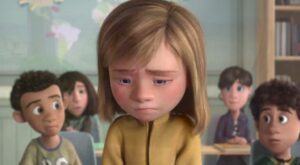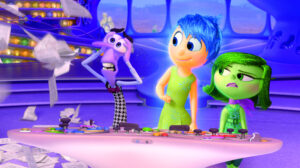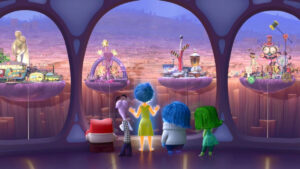Inside Out (2015) review
Dir. Pete Docter
By: Steve Pulaski
Rating: ★★★★
Pixar’s Inside Out may be the most heartfelt and morally honest film the renowned animated studio has made in their now two decades of operations. This film is an all-encompassing testament to the animated studio’s ability to please audiences of all ages, innovate new designs and atmospheres to their already immaculately detailed environments, explore uncharted realms in the field, and give people a film that seriously makes them look at themselves introspectively. This is more than a film people, kids and parents, will want to see, but a film they will need to see.
This is a film that’s far easier to watch than it is to explain. We are greeted with Riley Anderson (voiced by Kaitlyn Dias), a spunky eleven-year-old who loves hockey but is undergoing a move from Minnesota to San Francisco that will drastically change her life. She’ll have to make new friends, adjust to a new environment, and really attempt to fit in, as she’s entering a very tumultuous time in life.

This will obviously cause an emotional rollercoaster for her, which is why we spend most of our time inside Riley’s mind, where we meet her emotions. Joy (Amy Poehler) is her most prominent emotion, commanding the headquarters of Riley’s mind so that she is the happy, cheerful little girl we always see. Riley’s supporting emotions are Sadness (Phyllis), Fear (Bill Hader), Anger (Lewis Black), and Disgust (Mindy Kaling), all of whom chiming in at one point or another, but with Joy frequently commanding the ride. However, when Sadness causes a serious accident, resulting in the loss of Riley’s core memories, Sadness and Joy, along with the core memories, are subsequently sucked into the subconscious mind of Riley. Here, Riley cannot access her memories of Sadness and Joy, nor her core memories, leaving her with the inability to express any emotion besides fear, anger, and disgust.
As a result, Sadness and Joy must work their way back to the headquarters of Riley’s mind, a task that need be completed soon or every defining asset of Riley cherishes, be it hockey, her family, or her goofy side, will crumble, leaving her an empty shell of a human with the inability to feel.
As a reminder, Inside Out is not nearly this confusing to follow. In fact, it’s rather amazing how writer/director Pete Docter (Monster’s Inc, Up) and the remaining screenwriting team of Meg LeFauve and Josh Cooley make this film so easily accessible to kids. Kids will instantly recognize the playfulness of the emotions controlling Riley’s mind, and, presumably as a result, consider how their own emotions impact them on a daily basis. The incredible cast of voice actors shouldn’t go unnoticed, as they’re essentially playing the bare basics of characters by predicating themselves on one core emotion. However, surprisingly so, one of the most memorable and heartfelt characters isn’t an emotion, but Bing Bong (Richard Kind), Riley’s imaginary friend who guides Sadness and Joy through the different depths of Riley’s mind. Kind voices Bing Bong with a potent sense of happiness and sadness, making him one of the most sympathetic animated characters in recent memories. As Poehler describes him in a Q&A, his character is like a vaudeville actor pining to prove himself during one last performance.

It’s redundant to continue to praise Pixar’s exquisitely detailed visual effects, so let’s focus on the meatier aspects of Inside Out, like its emotional relevance with its audience. This is the very definition of a crowd-pleasing film. We can all recall a time when our emotions got the best of us and we said things we didn’t mean, or recall when our emotions were so indescribable we could barely think straight. It also houses the valuable lesson that, in order for a mind to fully operate, every emotion must play a part (a rude but necessary awakening for Joy). Inside Out makes you imagine this sort of scenario going on in your own head by not only focusing on Riley’s mind but flawlessly segwaying the story to show how the minds of others work (the scene during the end credits is comedic gold in terms of carrying this idea to the fullest). Furthermore, so many elements had to be considered for this kind of film, such as portraying the emotions of the five main emotions, as well as making their personalities likable despite the emotions they’re representing. Docter, LeFauve, and Cooley handle this in an incredibly dignified manner.
The only thing burdening Inside Out, ultimately, is its lack of emotional subtlety. When you’re making a motion picture revolving so blatantly around emotions (or, as the tagline cleverly puts it, a “major emotion picture”), you’re going to have a film that leaves few emotions unexploited. With Inside Out, while it doesn’t crank up the mawkishness to cloying levels, it does inevitably leave the film dictating your own emotions while you watch the film. Yet, this isn’t as big of a problem as it should be, mainly because rather than amplifying pathos, the trio of writers are more compelled with trying to craft an innovative and unique moviegoing/moviewatching experience for the audience, which is evident with nearly every frame in the film.
Inside Out is a culmination of a craft Pixar has held for two decades, which have been filled with ostensibly everything active imaginations and incorruptible creativity can conjure up. The fact that they’ll likely continue down this path, despite ostensibly making one idea that’s better than the next, is something that will almost always leave me excited.
NOTE: As of this writing, Inside Out is available to stream on Disney+.
Voiced by: Amy Poehler, Phyllis Smith, Richard Kind, Bill Hader, Lewis Black, Mindy Kaling, Kaitlyn Dias, Diane Lane, and Kyle MacLachlan. Directed by: Pete Docter.
About Steve Pulaski
Steve Pulaski has been reviewing movies since 2009 for a barrage of different outlets. He graduated North Central College in 2018 and currently works as an on-air radio personality. He also hosts a weekly movie podcast called "Sleepless with Steve," dedicated to film and the film industry, on his YouTube channel. In addition to writing, he's a die-hard Chicago Bears fan and has two cats, appropriately named Siskel and Ebert!


